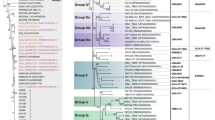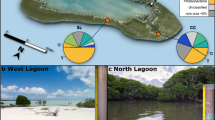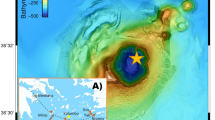Abstract
Phaeobacter gallaeciensis, a member of the abundant marine Roseobacter clade, is known to be an effective colonizer of biotic and abiotic marine surfaces. Production of the antibiotic tropodithietic acid (TDA) makes P. gallaeciensis a strong antagonist of many bacteria, including fish and mollusc pathogens. In addition to TDA, several other secondary metabolites are produced, allowing the mutualistic bacterium to also act as an opportunistic pathogen. Here we provide the manually annotated genome sequences of the P. gallaeciensis strains DSM 17395 and 2.10, isolated at the Atlantic coast of north western Spain and near Sydney, Australia, respectively. Despite their isolation sites from the two different hemispheres, the genome comparison demonstrated a surprisingly high level of synteny (only 3% nucleotide dissimilarity and 88% and 93% shared genes). Minor differences in the genomes result from horizontal gene transfer and phage infection. Comparison of the P. gallaeciensis genomes with those of other roseobacters revealed unique genomic traits, including the production of iron-scavenging siderophores. Experiments supported the predicted capacity of both strains to grow on various algal osmolytes. Transposon mutagenesis was used to expand the current knowledge on the TDA biosynthesis pathway in strain DSM 17395. This first comparative genomic analysis of finished genomes of two closely related strains belonging to one species of the Roseobacter clade revealed features that provide competitive advantages and facilitate surface attachment and interaction with eukaryotic hosts.
Similar content being viewed by others
Log in or create a free account to read this content
Gain free access to this article, as well as selected content from this journal and more on nature.com
or
References
Alexander DB, Zuberer DA . (1991). Use of chrome azurol S reagents to evaluate siderophore production by rhizosphere bacteria. Biol Fert Soils 12: 39–45.
Amin SA, Green DH, Hart MC, Küpper FC, Sunda WG, Carrano CJ . (2009). Photolysis of iron-siderophore chelates promotes bacterial-algal mutualism. Proc Natl Acad Sci USA 106: 17071–17076.
Auger S, Gomez MP, Danchin A, Martin-Verstraete I . (2005). The PatB protein of Bacillus subtilis is a C-S-lyase. Biochimie 87: 231–238.
Balcázar JL, Lee NM, Pintado J, Planas M . (2010). Phylogenetic characterization and in situ detection of bacterial communities associated with seahorses (Hippocampus guttulatus) in captivity. Syst Appl Microbiol 33: 71–77.
Barbieri E, Paster BJ, Hughes D, Zurek L, Moser DP, Teske A et al (2001). Phylogenetic characterization of epibiotic bacteria in the accessory nidamental gland and egg capsules of the squid Loligo pealei (Cephalopoda:Loliginidae). Environ Microbiol 3: 151–167.
Barra L, Fontenelle C, Ermel G, Trautwetter A, Walker GC, Blanco C . (2006). Interrelations between glycine betaine catabolism and methionine biosynthesis in Sinorhizobium meliloti strain 102F34. J Bacteriol 188: 7195–7204.
Berger M, Brock NL, Liesegang H, Dogs M, Preuth I, Simon M et al (2012). Genetic analysis of the upper phenylacetate catabolic pathway in the production of tropodithietic acid by Phaeobacter gallaeciensis. Appl Environ Microbiol 78: 3539–3551.
Berger M, Neumann A, Schulz S, Simon M, Brinkhoff T . (2011). Tropodithietic acid production in Phaeobacter gallaeciensis is regulated by N-Acyl Homoserine Lactone-mediated Quorum Sensing. J Bacteriol 193: 6576–6585.
Brinkhoff T, Bach G, Heidorn T, Liang L, Schlingloff A, Simon M . (2004). Antibiotic production by a Roseobacter clade-affiliated species from the German Wadden Sea and its antagonistic effects on indigenous isolates. Appl Environ Microbiol 70: 2560–2565.
Brinkhoff T, Giebel HA, Simon M . (2008). Diversity, ecology, and genomics of the Roseobacter clade: a short overview. Arch Microbiol 189: 531–539.
Bruhn JB, Nielsen KF, Hjelm M, Hansen M, Bresciani J, Schulz S et al (2005). Ecology, inhibitory activity, and morphogenesis of a marine antagonistic bacterium belonging to the Roseobacter clade. Appl Environ Microbiol 71: 7263–7270.
Cane DE, Wu Z, Van Epp JE . (1992). Thiotropocin biosynthesis. Shikimate origin of a sulfur-containing tropolone derivative. J Am Chem Soc 114: 8479–8483.
Carson KC, Holliday S, Glenn AR, Dilworth MJ . (1992). Siderophore and organic acid production in root nodule bacteria. Arch Microbiol 157: 264–271.
Carver T, Thomson N, Bleasby A, Berriman M, Parkhill J . (2009). DNAPlotter: circular and linear interactive genome visualization. Bioinformatics 25: 119–120.
Cheetham BF, Katz ME . (1995). A role for bacteriophages in the evolution and transfer of bacterial virulence determinants. Mol Microbiol 18: 201–208.
Chen F, Wang K, Stewart J, Belas R . (2006). Induction of multiple prophages from a marine bacterium: a genomic approach. Appl Environ Microbiol 72: 4995–5001.
Collins AJ, Nyholm SV . (2011). Draft genome of Phaeobacter gallaeciensis ANG1, a dominant member of the accessory nidamental gland of Euprymna scolopes. J Bacteriol 193: 3397–3398.
Danhorn T, Fuqua C . (2007). Biofilm formation by plant-associated bacteria. Annu Rev Microbiol 61: 401–422.
Darling ACE, Mau B, Blattner FR, Perna NT . (2004). Mauve: multiple alignment of conserved genomic sequence with rearrangements. Genome Res 14: 1394–1403.
Fuhrman JA . (1999). Marine viruses and their biogeochemical and ecological effects. Nature 399: 541–548.
Garrow TA . (1996). Purification, kinetic properties, and cDNA cloning of mammalian betaine-homocysteine methyltransferase. J Biol Chem 271: 22831–22838.
Geng H, Bruhn JB, Nielsen KF, Gram L, Belas R . (2008). Genetic dissection of tropodithietic acid biosynthesis by marine roseobacters. Appl Environ Microbiol 74: 1535–1545.
Glaser P . (1995). Incorporation of D-Alanine into lipoteichoic acid and wall teichoic acid in Bacillus subtilis. J Biol Chem 270: 15598–15606.
Gorshkova RP, Isakov VV, Shevchenko LS, Ivanova EP, Denisenko VA, Nazarenko EL . (2007). Structure of teichoic acid from the marine proteobacterium Sulfitobacter brevis KMM 6006. Chem Nat Compd 43: 643–647.
Gram L, Melchiorsen J, Bruhn JB . (2010). Antibacterial activity of marine culturable bacteria collected from a global sampling of ocean surface waters and surface swabs of marine organisms. Mar Biotechnol 12: 439–451.
Grigioni S, Boucher-Rodoni R, Demarta A, Tonolla M, Peduzzi R . (2000). Phylogenetic characterisation of bacterial symbionts in the accessory nidamental glands of the sepioid Sepia officinalis (Cephalopoda: Decapoda). Mar Biol 136: 217–222.
Gross M, Cramton SE, Götz F, Peschel A . (2001). Key role of teichoic acid net charge in Staphylococcus aureus colonization of artificial surfaces. Infect Immun 69: 3423–3426.
Grossart HP, Levold F, Allgaier M, Simon M, Brinkhoff T . (2005). Marine diatom species harbour distinct bacterial communities. Environ Microbiol 7: 860–873.
Hjelm M, Riaza A, Formoso F, Melchiorsen J, Gram L . (2004). Seasonal incidence of autochthonous antagonistic Roseobacter spp. and Vibrionaceae strains in a turbot larva (Scophthalmus maximus) rearing system. Appl Environ Microbiol 70: 7288–7294.
Homann VV, Edwards KJ, Webb EA, Butler A . (2009). Siderophores of Marinobacter aquaeolei: petrobactin and its sulfonated derivatives. Biometals 22: 565–571.
Hotta K, Kim CY, Fox DT, Koppisch AT . (2010). Siderophore-mediated iron acquisition in Bacillus anthracis and related strains. Microbiology 156: 1918–1925.
Ivars-Martinez E, Martin-Cuadrado AB, D’Auria G, Mira A, Ferriera S, Johnson J et al (2008). Comparative genomics of two ecotypes of the marine planktonic copiotroph Alteromonas macleodii suggests alternative lifestyles associated with different kinds of particulate organic matter. ISME J 2: 1194–1212.
Kalhoefer D, Thole S, Voget S, Lehman R, Liesegang H, Wollherr A et al (2011). Comparative genome analysis and genome-guided physiological analysis of Roseobacter litoralis. BMC Genomics 12.
Karp PD, Ouzounis CA, Moore-Kochlacs C, Goldovsky L, Kaipa P, Ahrén D et al (2005). Expansion of the BioCyc collection of pathway/genome databases to 160 genomes. Nucleic Acids Res 33: 6083–6089.
Karp PD, Paley S, Romero P . (2002). The Pathway Tools software. Bioinformatics 18: S225–S232.
Kereszt a, Kiss E, Reuhs BL, Carlson RW, Kondorosi A, Putnoky P . (1998). Novel rkp gene clusters of Sinorhizobium meliloti involved in capsular polysaccharide production and invasion of the symbiotic nodule: the rkpK gene encodes a UDP-glucose dehydrogenase. J Bacteriol 180: 5426–5431.
Kobayashi I . (2001). Behavior of restriction–modification systems as selfish mobile elements and their impact on genome evolution. Nucleic Acids Res 29: 3742–3756.
Lang AS, Beatty JT . (2001). The gene transfer agent of Rhodobacter capsulatus and “constitutive transduction” in prokaryotes. Arch Microbiol 175: 241–249.
Lang AS, Beatty JT . (2007). Importance of widespread gene transfer agent genes in alpha-proteobacteria. Trends Microbiol 15: 54–62.
Langille MGI, Brinkman FSL . (2009). IslandViewer: an integrated interface for computational identification and visualization of genomic islands. Bioinformatics 25: 664–665.
Majer F, Schmid DG, Altena K, Bierbaum G, Kupke T . (2002). The flavoprotein MrsD catalyzes the oxidative decarboxylation reaction involved in formation of the peptidoglycan biosynthesis inhibitor mersacidin. J Bacteriol 184: 1234–1243.
Martens T, Gram L, Grossart HP, Kessler D, Muller R, Simon M et al (2007). Bacteria of the Roseobacter clade show potential for secondary metabolite production. Microb Ecol 54: 31–42.
Martens T, Heidorn T, Pukall R, Simon M, Tindall BJ, Brinkhoff T . (2006). Reclassification of Roseobacter gallaeciensis Ruiz-Ponte et al. 1998 as Phaeobacter gallaeciensis gen. nov., comb. nov., description of Phaeobacter inhibens sp. nov., reclassification of Ruegeria algicola (Lafay et al. 1995) Uchino et al. 1999 as Marinovum. Int J Syst Evol Microbiol 56: 1293–1304.
Mira A . (2002). Microbial genome evolution: sources of variability. Curr Opin Microbiol 5: 506–512.
Mobberley JM, Authement RN, Segall AM, Paul JH . (2008). The temperate marine phage PhiHAP-1 of Halomonas aquamarina possesses a linear plasmid-like prophage genome. J Virol 82: 6618–6630.
Moran MA, Belas R, Schell MA, González JM, Sun F, Sun S et al (2007). Ecological genomics of marine roseobacters. Appl Environ Microbiol 73: 4559–4569.
Moreira LM, Becker JD, Puhler A, Becker A . (2000). The Sinorhizobium meliloti ExpE1 protein secreted by a type I secretion system involving ExpD1 and ExpD2 is required for biosynthesis or secretion of the exopolysaccharide galactoglucan. Microbiology 146: 2237–2248.
Murphy MJ, Siegel LM . (1973). Siroheme and sirohydrochlorin. The basis for a new type of porphyrin-related prosthetic group common to both assimilatory and dissimilatory sulfite reductases. J Biol Chem 248: 6911–6919.
Nekrasov SV, Agafonova OV, Belogurova NG, Delver EP, Belogurov AA . (2007). Plasmid-encoded antirestriction protein ArdA can discriminate between type I methyltransferase and complete restriction-modification system. J Mol Biol 365: 284–297.
Neuhaus FC, Baddiley J . (2003). A continuum of anionic charge: structures and functions of D-alanyl-teichoic acids in gram-positive bacteria. Microbiol Mol Biol Rev 67: 686–723.
Newton RJ, Griffin LE, Bowles KM, Meile C, Gifford S, Givens CE et al (2010). Genome characteristics of a generalist marine bacterial lineage. ISME J 4: 784–798.
Overbeek R, Larsen N, Walunas T, DSouza M, Pusch G, Selkov EJ et al (2003). The ERGO genome analysis and discovery system. Nucleic Acids Res 31: 164–171.
Park J-H, Dorrestein PC, Zhai H, Kinsland C, McLafferty FW, Begley TP . (2003). Biosynthesis of the thiazole moiety of thiamin pyrophosphate (vitamin B1). Biochemistry 42: 12430–12438.
Pena A, Teeling H, Huerta-Cepas J, Santos F, Yarza P, Brito-Echeverría J et al (2010). Fine-scale evolution: genomic, phenotypic and ecological differentiation in two coexisting Salinibacter ruber strains. ISME J 4: 882–895.
Petersen J . (2011). Phylogeny and compatibility: plasmid classification in the genomics era. Arch Microbiol 193: 313–321.
Petersen J, Brinkmann H, Berger M, Brinkhoff T, Päuker O, Pradella S . (2011). Origin and evolution of a novel DnaA-like plasmid replication type in Rhodobacterales. Mol Biol Evol 28: 1229–1240.
Pfleger BF, Lee JY, Somu RV, Aldrich CC, Hanna PC, Sherman DH . (2007). Characterization and analysis of early enzymes for petrobactin biosynthesis in Bacillus anthracis. Biochemistry 46: 4147–4157.
Pommier T, Pinhassi J, Hagström Å . (2005). Biogeographic analysis of ribosomal RNA clusters from marine bacterioplankton. Aquat Microb Ecol 41: 79–89.
Poole K, Heinrichs DE, Neshat S . (1993). Cloning and sequence analysis of an EnvCD homologue in Pseudomonas aeruginosa: regulation by iron and possible involvement in the secretion of the siderophore pyoverdine. Mol Microbiol 10: 529–544.
Porsby CH, Nielsen KF, Gram L . (2008). Phaeobacter and Ruegeria species of the Roseobacter clade colonize separate niches in a Danish Turbot (Scophthalmus maximus)-rearing farm and antagonize Vibrio anguillarum under different growth conditions. Appl Environ Microbiol 74: 7356–7364.
Prado S, Montes J, Romalde JL, Juan LB . (2009). Inhibitory activity of Phaeobacter strains against aquaculture pathogenic bacteria. Int Microbiol 12: 107–114.
Rao D, Webb JS, Holmstrom C, Case R, Low A, Steinberg P et al (2007). Low densities of epiphytic bacteria from the marine alga Ulva australis inhibit settlement of fouling organisms. Appl Environ Microbiol 73: 7844–7852.
Rao D, Webb JS, Kjelleberg S . (2005). Competitive interactions in mixed-species biofilms containing the marine bacterium Pseudoalteromonas tunicata. Appl Environ Microbiol 71: 1729–1736.
Rao D, Webb JS, Kjelleberg S . (2006). Microbial colonization and competition on the marine alga Ulva australis. Appl Environ Microbiol 72: 5547–5555.
Rocap G, Larimer FW, Lamerdin J, Malfatti S, Chain P, Ahlgren NA et al (2003). Genome divergence in two Prochlorococcus ecotypes reflects oceanic niche differentiation. Nature 424: 1042–1047.
Rudrappa T, Biedrzycki ML, Kunjeti SG, Donofrio NM, Czymmek KJ, Paré PW et al (2010). The rhizobacterial elicitor acetoin induces systemic resistance in Arabidopsis thaliana. Commun Integr Biol 3: 130–138.
Ruiz-Ponte C, Cilia V, Lambert C, Nicolas JL . (1998). Roseobacter gallaeciensis sp. nov., a new marine bacterium isolated from rearings and collectors of the scallop Pecten maximus. Int J Syst Bacteriol 48: 537–542.
Ryu C-M, Farag MA, Hu C-H, Reddy MS, Wei H-X, Paré PW et al (2003). Bacterial volatiles promote growth in Arabidopsis. Proc Natl Acad Sci USA 100: 4927–4932.
Schloter M, Lebuhn M, Heulin T, Hartmann A . (2000). Ecology and evolution of bacterial microdiversity. FEMS Microbiol Rev 24: 647–660.
Schwyn B, Neilands JB . (1987). Universal chemical assay for the detection and determination of siderophores. Anal Biochem 160: 47–56.
Sekiguchi H, Koshikawa H, Hiroki M, Murakami S, Xu K, Watanabe M et al (2002). Bacterial distribution and phylogenetic diversity in the Changjiang estuary before the construction of the Three Gorges Dam. Microb Ecol 43: 82–91.
Seyedsayamdost MR, Case RJ, Kolter R, Clardy J . (2011). The Jekyll-and-Hyde chemistry of Phaeobacter gallaeciensis. Nat Chem 3: 331–335.
Shea CM, McIntosh MA . (1991). Nucleotide sequence and genetic organization of the ferric enterobactin transport system: homology to other periplasmic binding protein-dependent systems in Escherichia coli. Mol Microbiol 5: 1415–1428.
Silva ACR da, Ferro JA, Reinach FC, Farah CS, Furlan LR, Quaggio RB et al (2002). Comparison of the genomes of two Xanthomonas pathogens with differing host specificities. Nature 417: 459–463.
Skorupska A, Janczarek M, Marczak M, Mazur A, Król J . (2006). Rhizobial exopolysaccharides: genetic control and symbiotic functions. Microb Cell Fact 5: 7.
Sofia HJ, Chen G, Beth GH, Reyes-Spindola JF, Miller NE . (2001). Radical SAM, a novel protein superfamily linking unresolved steps in familiar biosynthetic pathways with radical mechanisms: functional characterization using new analysis and information visualization methods. Nucleic Acids Res 29: 1097–1106.
Soria-Dengg S, Reissbrodt R, Horstmann U . (2001). Siderophores in marine coastal waters and their relevance for iron uptake by phytoplankton: experiments with the diatom Phaeodactylum tricornutum. Mar Ecol Prog Ser 220: 73–82.
Staden R . (1996). The Staden sequence analysis package. Mol Biotechnol 5: 233–241.
Tatusov RL, Koonin EV, Lipman DJ . (1997). A genomic perspective on protein families. Science 278: 631–637.
Tech M, Merkl R . (2003). YACOP: Enhanced gene prediction obtained by a combination of existing methods. In Silico Biol 3: 441–451.
Teufel R, Gantert C, Voss M, Eisenreich W, Haehnel W, Fuchs G . (2011). Studies on the mechanism of ring-hydrolysis in phenylacetate degradation - A metabolic branching point. J Biol Chem 286: 11021–11034.
Teufel R, Mascaraque V, Ismail W, Voss M, Perera J, Eisenreich W et al (2010). Bacterial phenylalanine and phenylacetate catabolic pathway revealed. Proc Natl Acad Sci USA 107: 14390–14395.
Thiel V, Brinkhoff T, Dickschat JS, Wickel S, Grunenberg J, Wagner-Döbler I et al (2010). Identification and biosynthesis of tropone derivatives and sulfur volatiles produced by bacteria of the marine Roseobacter clade. Org Biomol Chem 8: 234–246.
Thomas T, Evans FF, Schleheck D, Mai-Prochnow A, Burke C, Penesyan A et al (2008). Analysis of the Pseudoalteromonas tunicata genome reveals properties of a surface-associated life style in the marine environment. PLoS One 3: e3252.
Vu B, Chen M, Crawford RJ, Ivanova EP . (2009). Bacterial extracellular polysaccharides involved in biofilm formation. Molecules 14: 2535–2554.
Waack S, Keller O, Asper R, Brodag T, Damm C, Fricke WF et al (2006). Score-based prediction of genomic islands in prokaryotic genomes using hidden Markov models. BMC Bioinformatics 7: 142.
Williamson SJ, Houchin LA, McDaniel L, Paul JH . (2002). Seasonal variation in lysogeny as depicted by prophage induction in Tampa Bay, Florida. Appl Environ Microbiol 68: 4307–4314.
Wyss M, Kaddurah-Daouk R . (2000). Creatine and creatinine metabolism. Physiol Rev 80: 1107–1213.
Zech H, Thole S, Schreiber K, Kalhoefer D, Voget S, Brinkhoff T et al (2009). Growth phase-dependent global protein and metabolite profiles of Phaeobacter gallaeciensis strain DSM 17395, a member of the marine Roseobacter clade. Proteomics 9: 3677–3697.
Acknowledgements
We thank Frauke-Dorothee Meyer, Anne Buthoff (Göttingen) and Renate Gahl-Janßen (Oldenburg) for excellent technical assistance. We also thank Stephan Schuster for support during the 454 pyrosequencing. This study was supported by the niedersächsisches VW-Vorab ‘Comparative and functional genome analysis of representative members of the Roseobacter clade’ (ZN2235), Germany, the Collaborative Research Center TRR 51 funded by Deutsche Forschungsgemeinschaft, Center for Marine Bio-Innovation, Australia, and the Marine Microbiology Initiative of the Gordon and Betty Moore Foundation, USA.
Author information
Authors and Affiliations
Corresponding author
Additional information
Supplementary Information accompanies the paper on The ISME Journal website
Supplementary information
Rights and permissions
About this article
Cite this article
Thole, S., Kalhoefer, D., Voget, S. et al. Phaeobacter gallaeciensis genomes from globally opposite locations reveal high similarity of adaptation to surface life. ISME J 6, 2229–2244 (2012). https://doi.org/10.1038/ismej.2012.62
Received:
Revised:
Accepted:
Published:
Issue date:
DOI: https://doi.org/10.1038/ismej.2012.62
Keywords
This article is cited by
-
Bacteria contribute exopolysaccharides to an algal-bacterial joint extracellular matrix
npj Biofilms and Microbiomes (2024)
-
Bacterial controlled mitigation of dysbiosis in a seaweed disease
The ISME Journal (2022)
-
The ability of Phaeobacter inhibens to produce tropodithietic acid influences the community dynamics of a microalgal microbiome
ISME Communications (2022)
-
The overlooked role of a biotin precursor for marine bacteria - desthiobiotin as an escape route for biotin auxotrophy
The ISME Journal (2022)
-
Population differentiation of Rhodobacteraceae along with coral compartments
The ISME Journal (2021)



